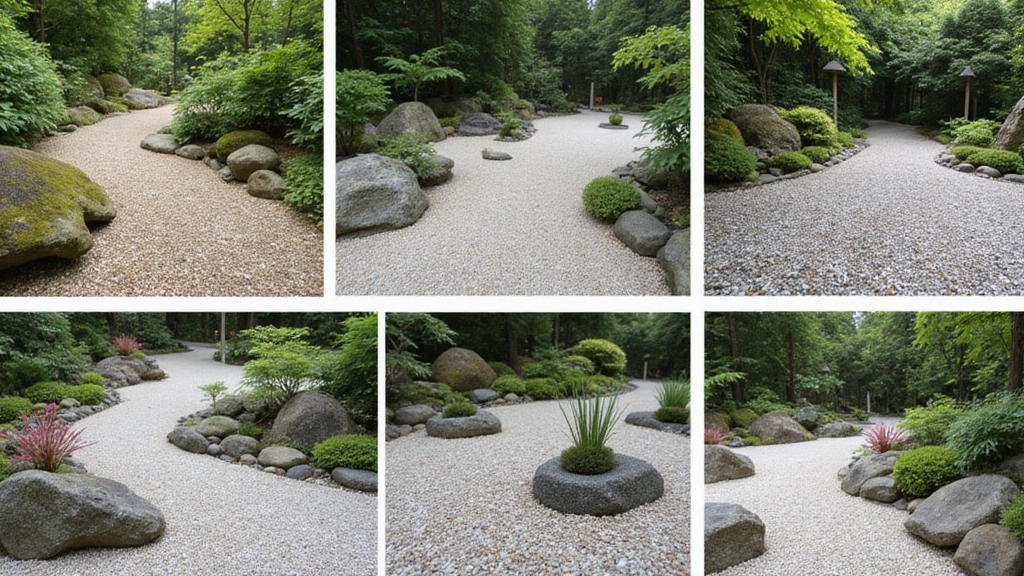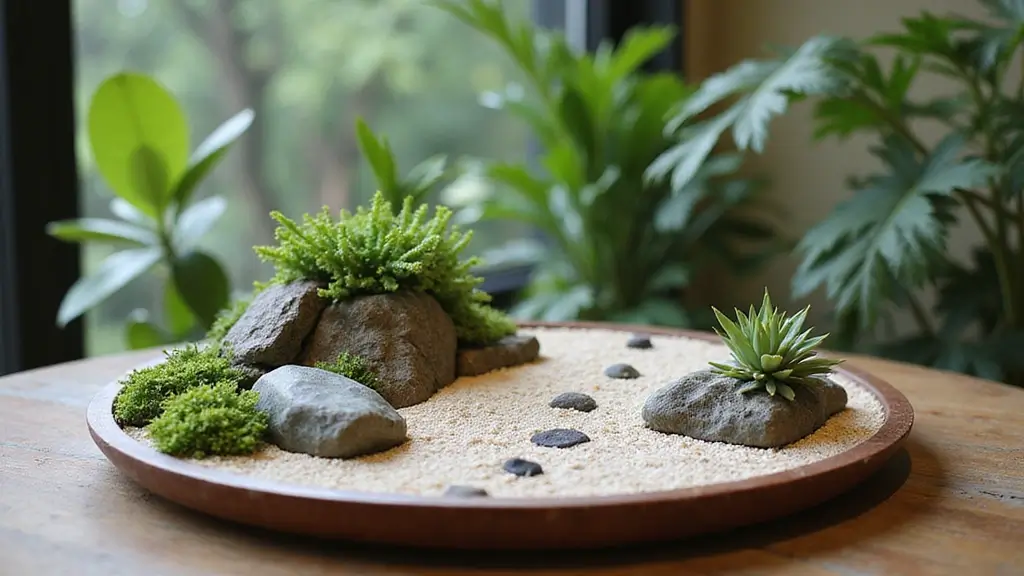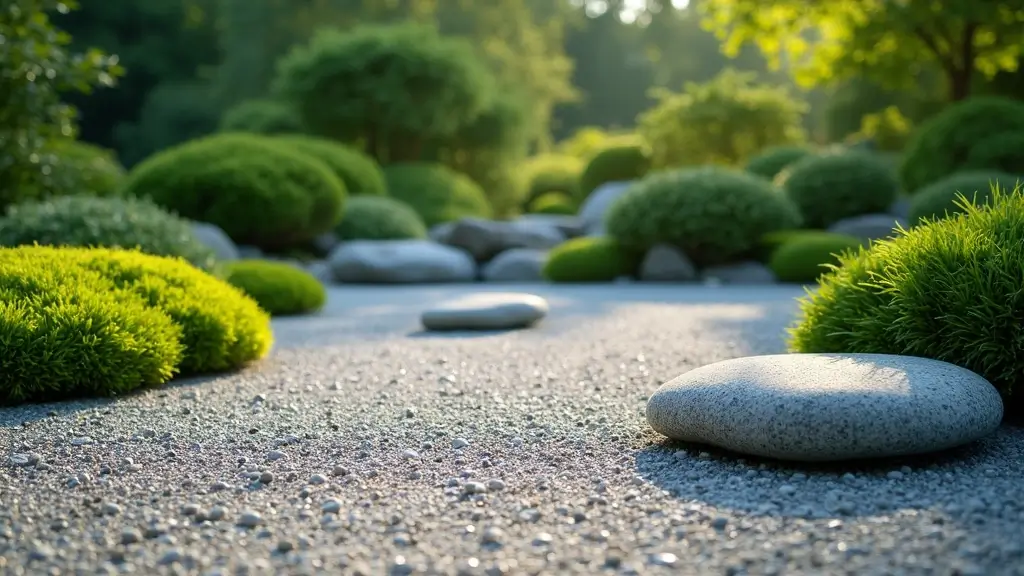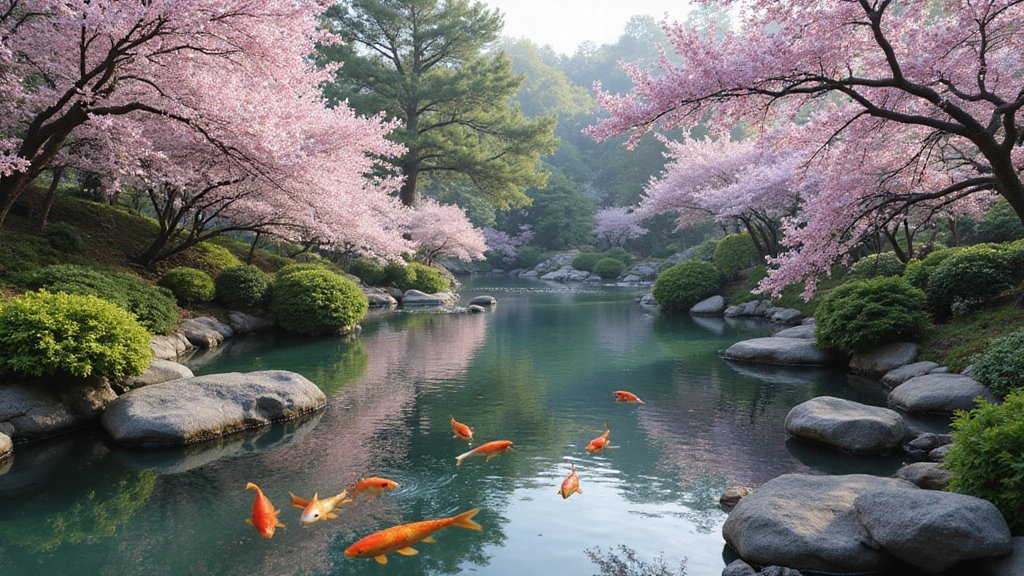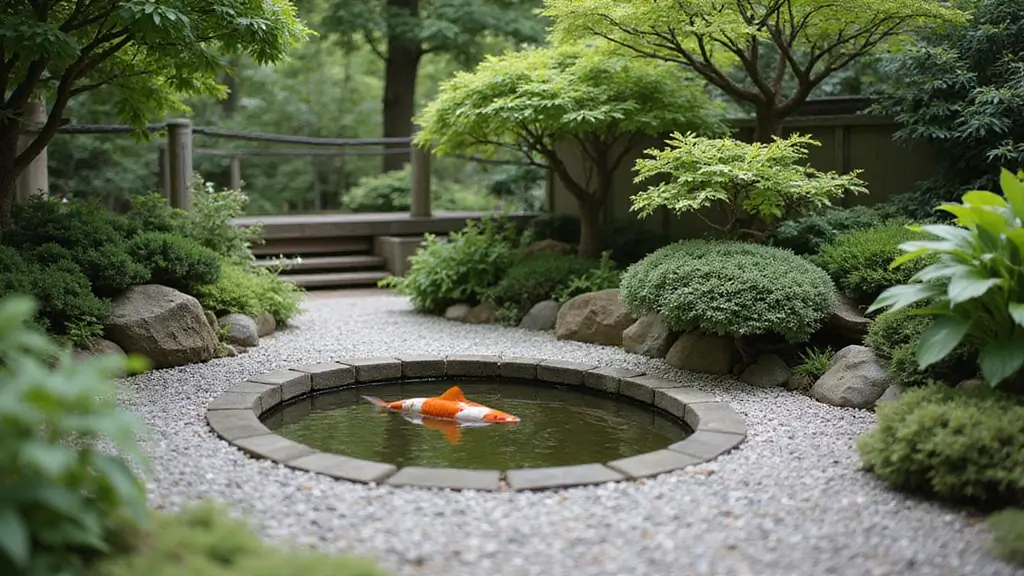Japanese Zen gardens are a stunning blend of artistry and tranquility, offering a retreat from the hustle and bustle of everyday life.
These gardens invite mindfulness, encouraging us to slow down and appreciate the beauty of simplicity. Whether you’re looking to transform a small backyard or a serene corner of your home, there’s something deeply calming about the minimalism and intentionality of these spaces.
We’ll explore 29 innovative concepts that embody the spirit of Zen gardening, focusing on sustainable practices and eco-friendly designs that fit seamlessly into the philosophy of permaculture. Get ready to take inspiration from elements like rocks, sand, water, and plants that create the perfect retreat for relaxation and reflection.
1. Minimalist Sand and Stone Layout
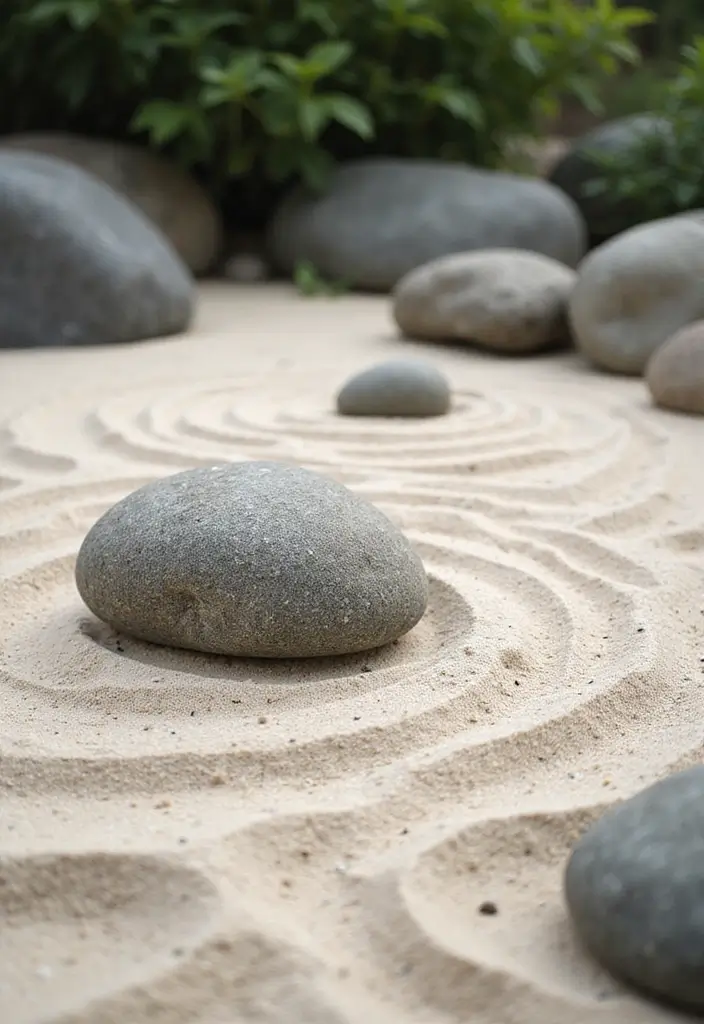
This design emphasizes simplicity with a minimalistic approach that highlights the beauty of raked sand and strategically placed stones.
Imagine a flat expanse of fine white sand, like sand for zen garden, gently raked into mesmerizing patterns, interrupted only by smooth, rounded stones that symbolize islands in a serene sea. This garden allows for deep contemplation as it draws the eye, encouraging you to take a moment to breathe and reflect.
Consider adding:
– Large boulders for focal points
– Small pebbles to fill in gaps with natural beauty, like natural river stones
– A variety of raking styles for texture using a Japanese zen garden rake
The beauty of this concept lies in its low maintenance. The materials used are natural and can often be sourced sustainably. Plus, it allows you to personalize your patterns with each raking session, making every visit to your garden unique.
Garden Tip: Incorporate windbreaks to shield your sandy masterpiece from strong winds, preserving its serene order.
2. Bonsai and Mini Zen Garden Combination
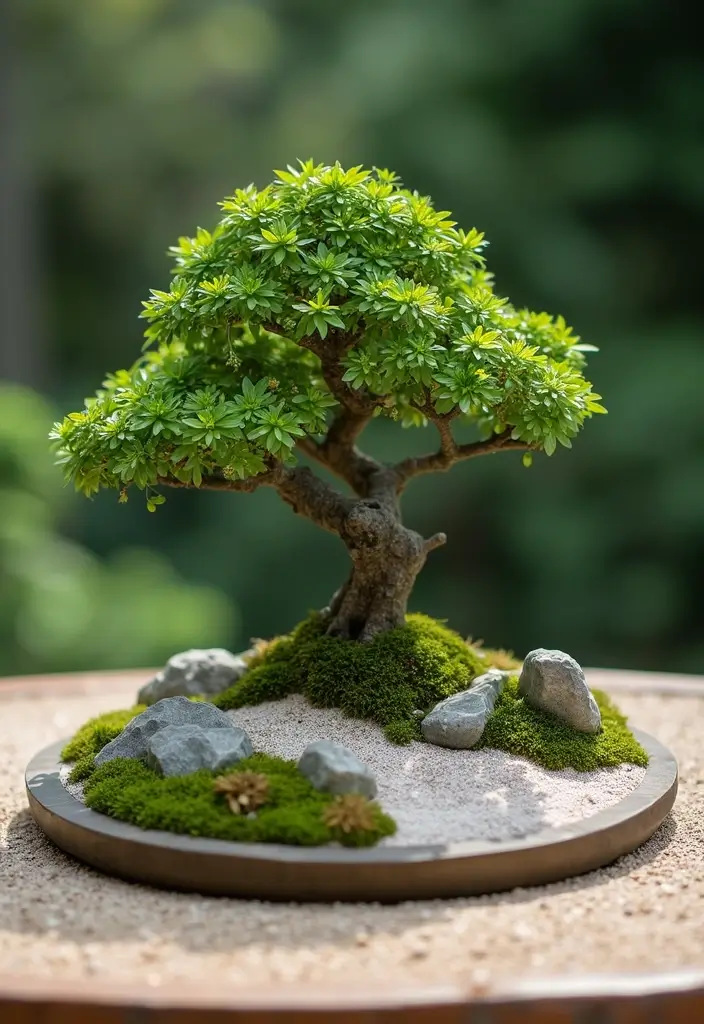
Bonsai trees and Zen gardens can create an enchanting miniaturized ecosystem that embodies harmony.
In a small space, a carefully placed bonsai can serve as a stunning focal point surrounded by a tiny Zen garden. Consider using a shallow tray filled with fine sand or gravel as your base. You can enhance your setup with the mini zen garden kit, which provides the essentials for creating that serene atmosphere. Incorporate miniature stones, such as the decorative pebbles for gardening, to simulate water and accentuate the bonsai. Adding moss can further elevate the aesthetics.
This arrangement not only beautifies your space but also serves as a reminder of nature’s beauty in a compact form. To start your journey, consider a bonsai tree starter kit, which includes various bonsai tree options and essential tools, making it perfect for beginners.
What to include:
– A carefully pruned bonsai tree
– Tiny pebbles or sand to simulate water
– Small figurines if you want to add a personal touch
The contrast of the delicate bonsai against the textured gravel makes for a visually appealing landscape. Manage its watering with care, as bonsais need both attention and love to thrive.
Garden Tip: Choose a bonsai variety that resonates with your aesthetic preferences, like a Juniper for its striking foliage.
3. Water Elements in Zen Gardens
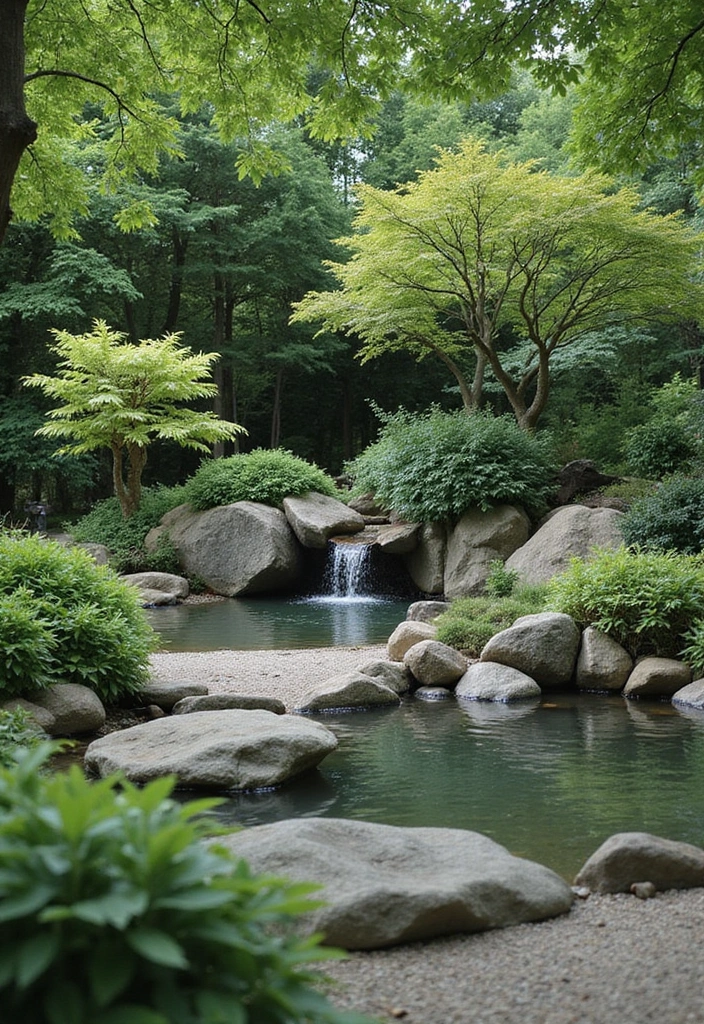
Water features bring a sense of calm and life to any Zen garden, often symbolizing purity and tranquility. Adding a small pond or a simple water bowl can dramatically enhance the atmosphere of your garden. The gentle sound of water can soothe the mind and create a peaceful experience.
Consider incorporating a koi pond that attracts wildlife, such as a Koi Pond Kit to ensure the water quality is optimal for your fish. This kit will help you monitor the health of your pond, making it a serene environment for both you and the wildlife it attracts.
For a soothing sound, a small fountain can work wonders. The Solar Water Fountain is a fantastic option that operates on solar power, reducing energy consumption while providing the calming sound of flowing water. Its free-standing design makes it a simple and effective addition to your garden.
You can also add a decorative element with a clear water bowl that reflects the sky. The Decorative Water Bowl offers a stylish option for this feature, blending seamlessly with the rocks and plants surrounding it.
These water features can be designed to fit harmoniously within your garden, enhancing biodiversity while promoting mindfulness.
Garden Tip: Ensure your water feature is eco-friendly by installing a solar pump, like the one mentioned, to maintain that soothing flow without impacting the environment negatively.
4. Seasonal Plant Selection
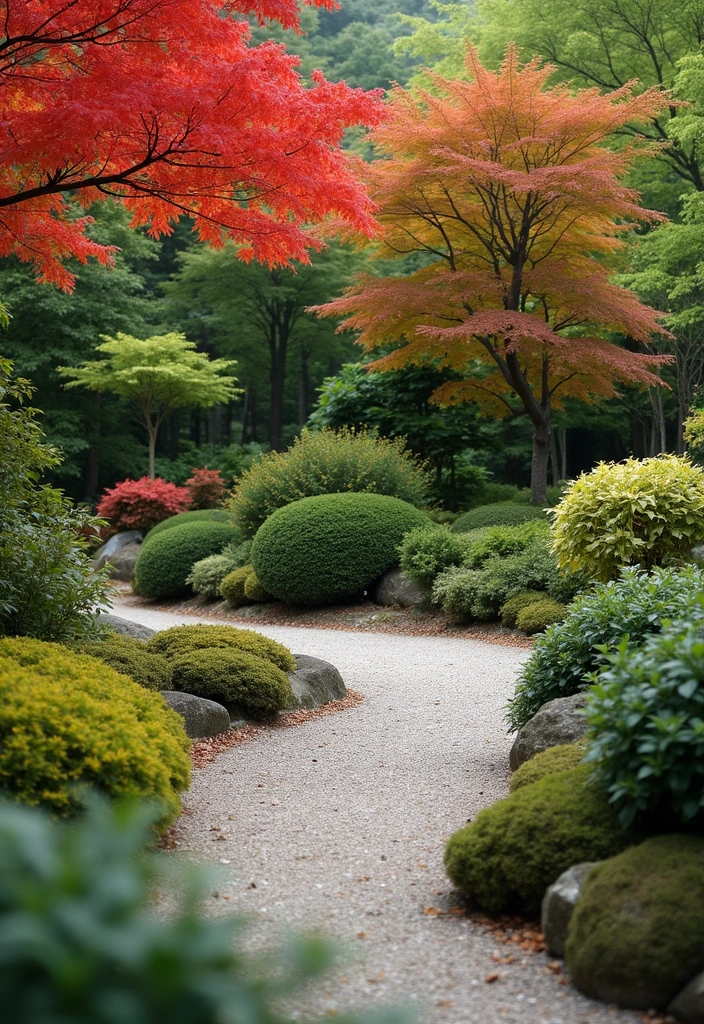
Incorporating plants that change with the seasons adds a dynamic element to your Zen garden. This approach reminds us of the natural cycles of life.
To create an evolving experience, select plants that bloom at different times of the year. For example, cherry blossoms in spring provide a stunning display, while vibrant autumn leaves create an entirely different landscape. Consider adding a Japanese Maple Tree for striking foliage; its bright red leaves in the fall can transform your garden into a captivating wonderland. Meanwhile, azaleas, like the Azalea Plant, offer a burst of color in spring, further enriching the garden’s aesthetics.
For a unique texture and height, consider incorporating bamboo with options like Bamboo Plant. Its graceful stalks add a calming presence to your space and can thrive with minimal care. Choosing the right variety enhances the garden’s ambiance throughout the year, making every visit a new experience.
Garden Tip: Group plants based on their watering needs to maintain a sustainable and low-maintenance area.
Embrace the beauty of change! By selecting seasonal plants for your Japanese Zen garden, you can create a living masterpiece that evolves with nature’s rhythms. Discover the peace in every blooming moment!
5. Rock Gardens with Unique Textures
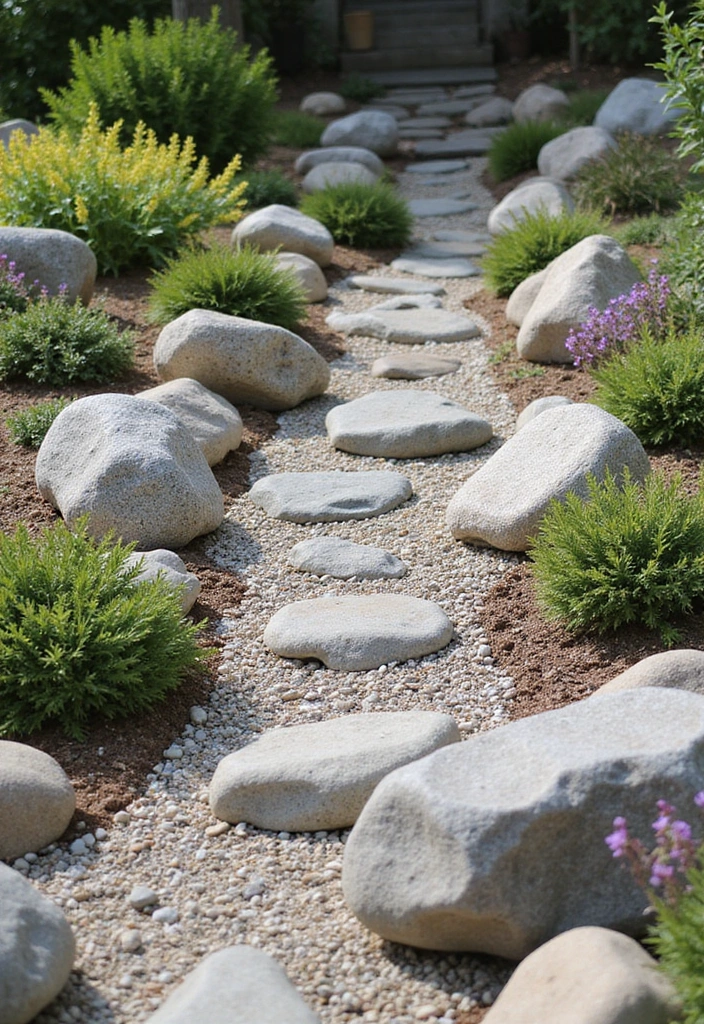
Rock gardens are a fantastic way to combine natural beauty with minimalist design. They make a bold statement and provide contrast to softer elements. By using a variety of rocks, from large boulders to small pebbles, you create layers and visual interest. The key is to arrange these stones in a manner that mimics nature, creating an organic flow.
To enhance your rock garden, consider using a garden rock collection featuring 20lbs of natural river rocks. These hand-picked smooth stones are perfect for adding that varied texture and can be used in pathways, flower pots, or even indoor water fountains.
Elements to consider include a mix of textures with different shapes and sizes, and raked gravel to enhance the design. A rake for gravel can help you achieve that perfect raked look, making it easier to level the gravel and maintain your garden’s aesthetic.
Don’t forget to add succulents or hardy plants that thrive in rocky environments, like the succulent plant assortment. This set includes a variety of live succulent plants that will add a vibrant touch to your garden while requiring minimal upkeep.
This design channels the raw beauty of nature while requiring minimal maintenance. It’s perfect for gardening enthusiasts looking for an eco-friendly option, as the stones can often be sourced locally.
Garden Tip: Ensure proper drainage by placing rocks in a way that avoids water pooling, which can damage plants.
A Japanese zen garden thrives on contrast – let the bold textures of rocks and the softness of plants create a dance of harmony that calms the mind and delights the senses.
6. Incorporating Pathways
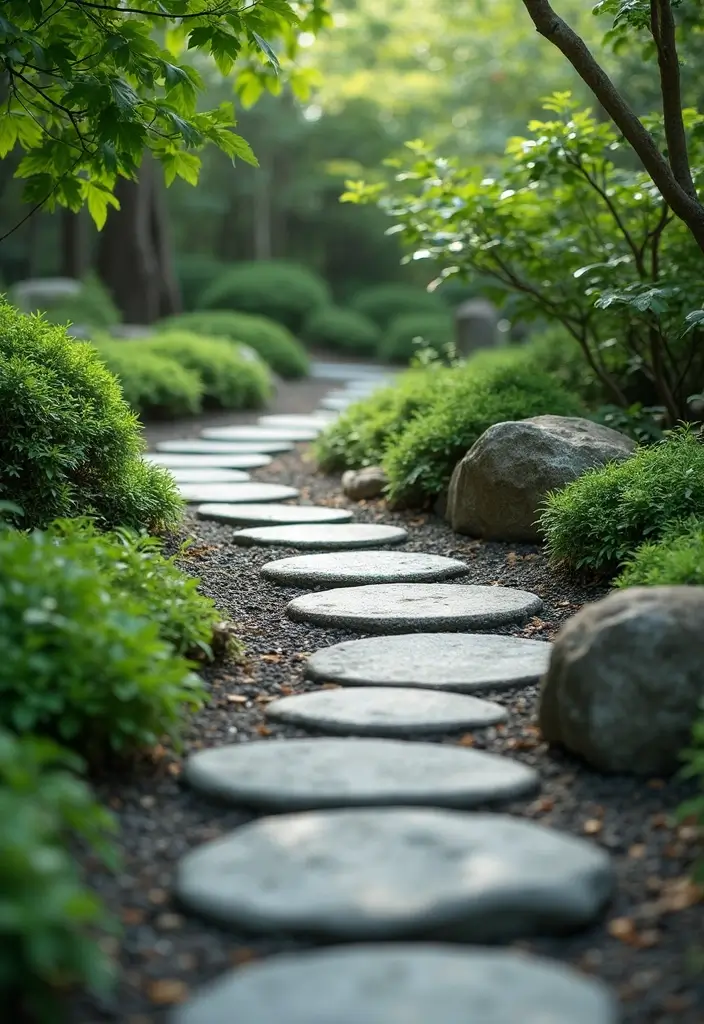
Pathways lead through your Zen garden, inviting exploration while providing structure. They can be made from materials like stepping stones, gravel, or wooden planks, connecting different areas of the garden. For a practical option, consider using natural stepping stones, which are easy to install and blend seamlessly with the surroundings.
A well-designed path encourages mindfulness as you walk through, slowing you down to appreciate the beauty around you. To enhance the experience, opt for curves instead of straight lines to mimic nature’s organic shapes. Surround your path with fragrant plants, adding an aromatic element to engage your senses.
Paths are not just functional; they also enhance the visual flow of your garden. Thoughtful planning can guide visitors to focal points like water features or seating areas. To define your pathways beautifully, consider using curved wooden garden edging. This decorative stone-look border helps maintain structure while creating an inviting atmosphere.
Garden Tip: To extend your enjoyment into the evening, add subtle lighting along the pathways with outdoor solar pathway lights. These lights not only enhance safety but also create an enchanting ambiance for nighttime strolls.
7. Zen Garden for Meditation
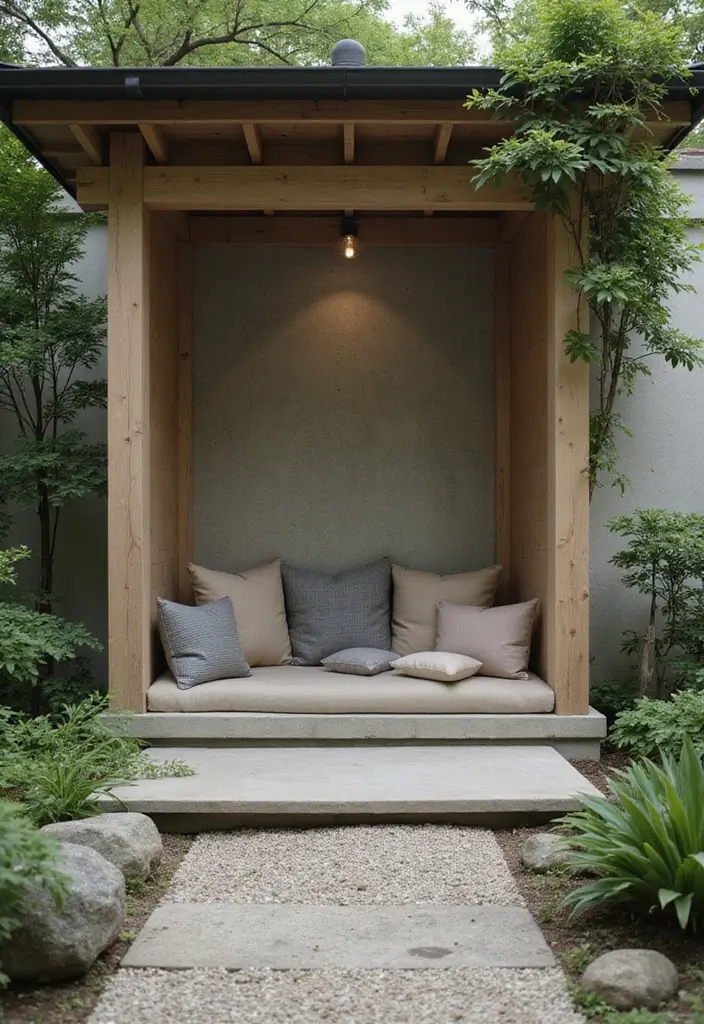
Designing a dedicated meditation space within your garden can profoundly enhance your practice. This area should evoke peace and silence, allowing for deeper reflection. Consider including comfortable seating options, like a Meditation Bench, crafted from sustainable acacia wood. Its curved bottom edges promote the perfect posture for your meditation sessions, helping you to stay comfortable and focused.
To create a sense of seclusion, incorporate a backdrop of plants that provides privacy. Decorative elements such as decorative lanterns can add a tranquil atmosphere, especially when lit in the evenings. These lanterns, featuring an LED pillar candle, are waterproof, making them ideal for outdoor settings while enhancing the serenity of your space.
Creating a designated area not only benefits your mental health but also encourages others to respect the space. Incorporate soft colors and gentle textures, perhaps with outdoor cushions that complement your meditation bench. These waterproof cushions add comfort to your seating arrangement, ensuring that you can enjoy quiet moments or practice yoga amidst the serenity of nature.
Garden Tip: Choose a quiet corner of your garden to enhance focus, away from distractions, and allow your meditation practice to flourish in a peaceful setting.
8. Eco-Friendly Practices in Zen Gardening
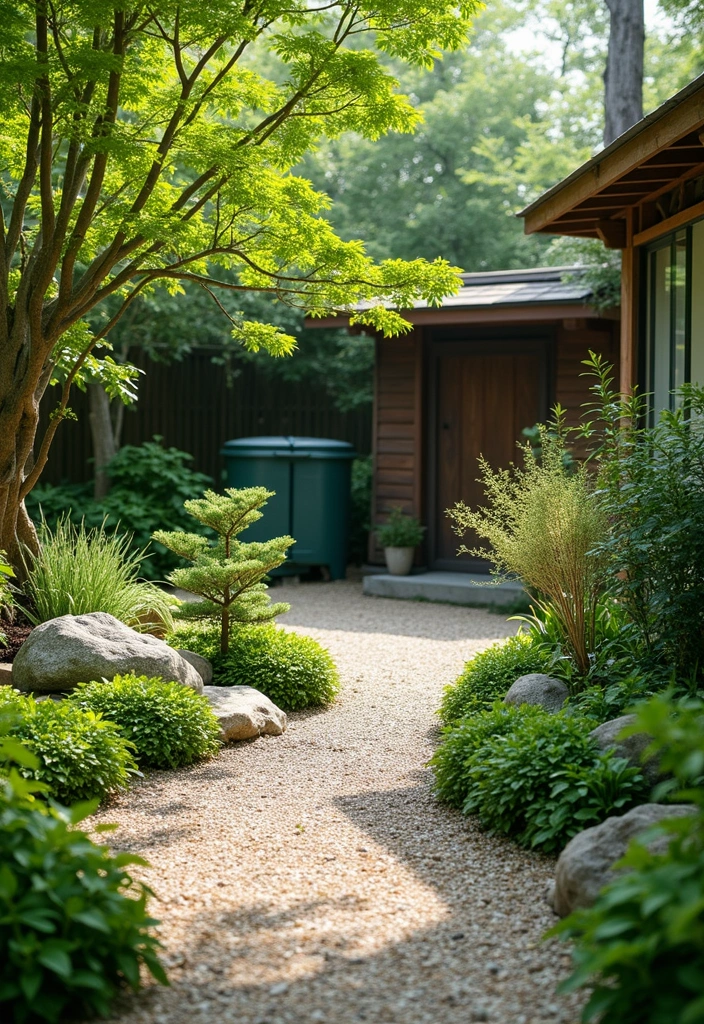
Sustainable gardening practices are at the heart of Zen gardening philosophy. The aim is to create an environment where everything coexists harmoniously.
Utilizing native plants promotes biodiversity and requires less water, while composting enriches the soil naturally. Here are some eco-friendly practices to adopt:
– Collect rainwater for irrigation with a rainwater collection system. This 53-gallon barrel is perfect for gathering rainwater and using it to nourish your garden, reducing your dependence on municipal water sources.
– Use organic mulch to retain moisture in the soil. This organic mulch not only helps maintain the soil’s moisture levels but also enhances the health of your plants by suppressing weeds and providing nutrients as it breaks down.
– Avoid chemical fertilizers in favor of organic options. Starting a small compost bin can be an effective way to recycle kitchen waste, turning it into nutrient-rich soil for your garden. This simple practice nurtures the earth instead of depleting it.
The focus on sustainability not only benefits your garden but contributes positively to the ecosystem. Garden Tip: Incorporate these practices to help create a serene and mindful gardening experience.
9. Rock Balancing Art

Rock balancing is a captivating art form that can bring a unique touch to your Zen garden. It involves stacking stones in a way that defies gravity, focusing the mind and enhancing concentration. To incorporate this in your garden, consider using natural river stones, which come in various sizes and shapes to allow for creativity in your design. These decorative river rocks not only enhance the visual impact but also provide a sturdy foundation for your balancing art.
When setting up your rock balancing display, start with larger stones as a base. Place smaller stones on top, ensuring stability as you experiment with different configurations to find beauty in balance. Keeping a collection of these stones aside for spontaneous balancing sessions can foster mindfulness and add a playful element to your garden.
To further enhance your rock balancing experience, you might find it helpful to consider a garden stone balancing kit for any additional tools you may need. This kit is especially useful if you’re looking to explore more complex balancing techniques.
Not only does this practice foster mindfulness, but it also becomes a delightful conversation starter for garden visitors. Remember to choose a setting that offers a backdrop of foliage or water to amplify the beauty of your creation.
10. Zen Garden with Edible Plants
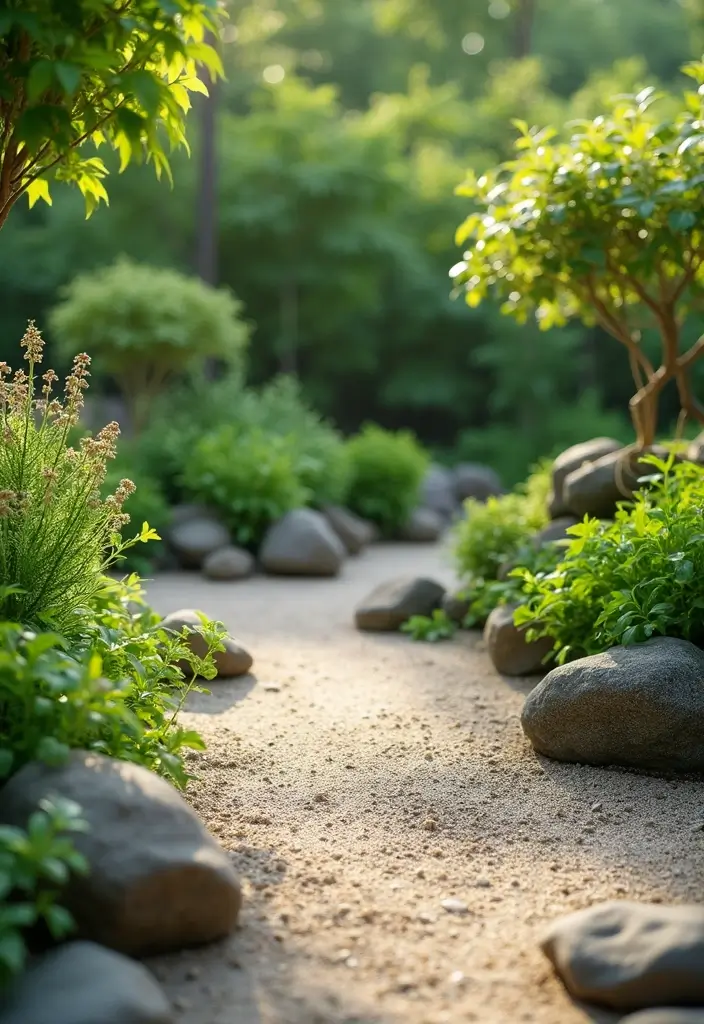
Who says Zen gardens can’t be functional? Incorporating edible plants brings a practical twist to your peaceful oasis.
You can design sections of your garden featuring herbs, vegetables, or fruits neatly organized among traditional Zen elements. This blend promotes sustainability while providing access to fresh ingredients. Consider planting leafy greens in raised beds using a raised garden bed kit for easy organization and maintenance. Herbs like basil and mint can thrive in gravel beds, making the herb garden starter kit an excellent choice for your indoor or outdoor space. Additionally, you might want to include fruit trees as focal points in your garden; a fruit tree starter kit provides a variety of seeds to help you cultivate delicious fruit right at home.
Designing this way reinforces the connection to nature, as you can nurture both beauty and sustenance. It’s a reminder that nature’s bounty can flourish in an aesthetic space.
Garden Tip: Group plants based on their sunlight and moisture needs for efficient growth.
11. Incorporating Bamboo
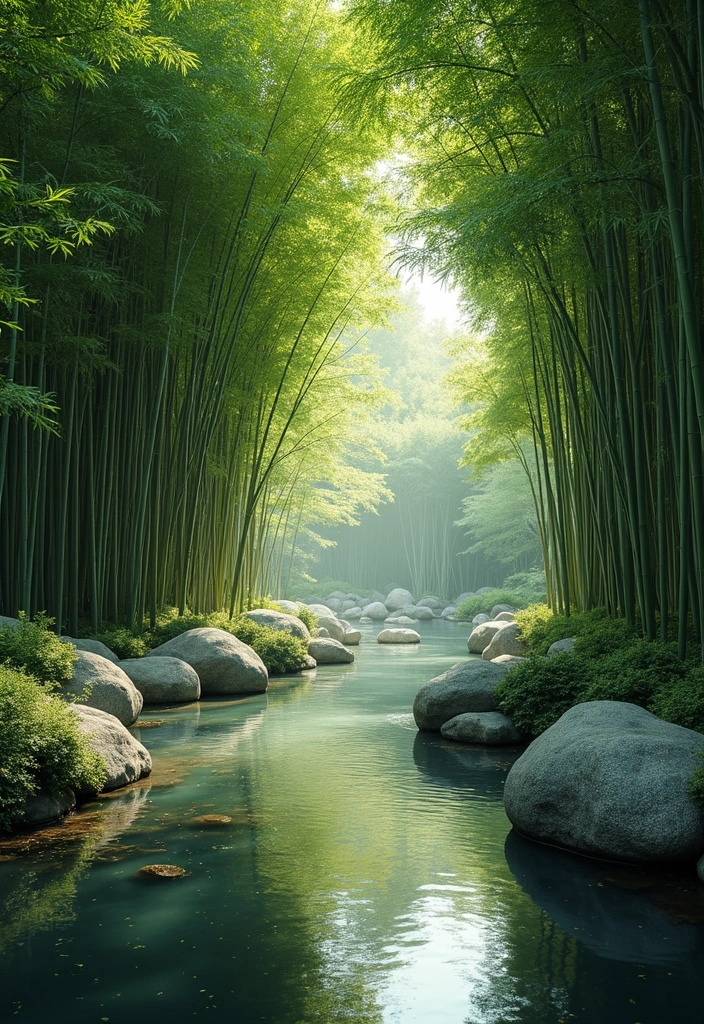
Bamboo is a versatile plant that adds height and elegance to any Zen garden. Its rustling leaves and sturdy growth can create a natural privacy screen or focal point. Consider planting a bamboo grove or using bamboo fencing, such as the Backyard X-Scapes natural bamboo fencing decorative rolled fence panel, to enhance the tranquility of your space. This fast-growing plant is not only beautiful but also eco-friendly, making it a perfect choice for sustainable gardening.
When selecting bamboo, think about choosing clumping varieties to control growth. The Bambusa eutuldoides – Asian lemon clumping bamboo plant is a wonderful option that offers both aesthetic appeal and manageable growth. Additionally, bamboo can be used for decorative elements like trellises. Consider adding a bamboo trellis to support climbing plants and enhance the visual interest of your garden.
If you need a sound barrier, bamboo screens can serve that purpose effectively, allowing you to create a peaceful retreat. The flexibility of bamboo allows for creativity in design, contributing to an enchanting atmosphere that is both calming and functional.
Garden Tip: Regularly prune to maintain the desired height and avoid overcrowding.
12. Zen Garden with Colorful Accents
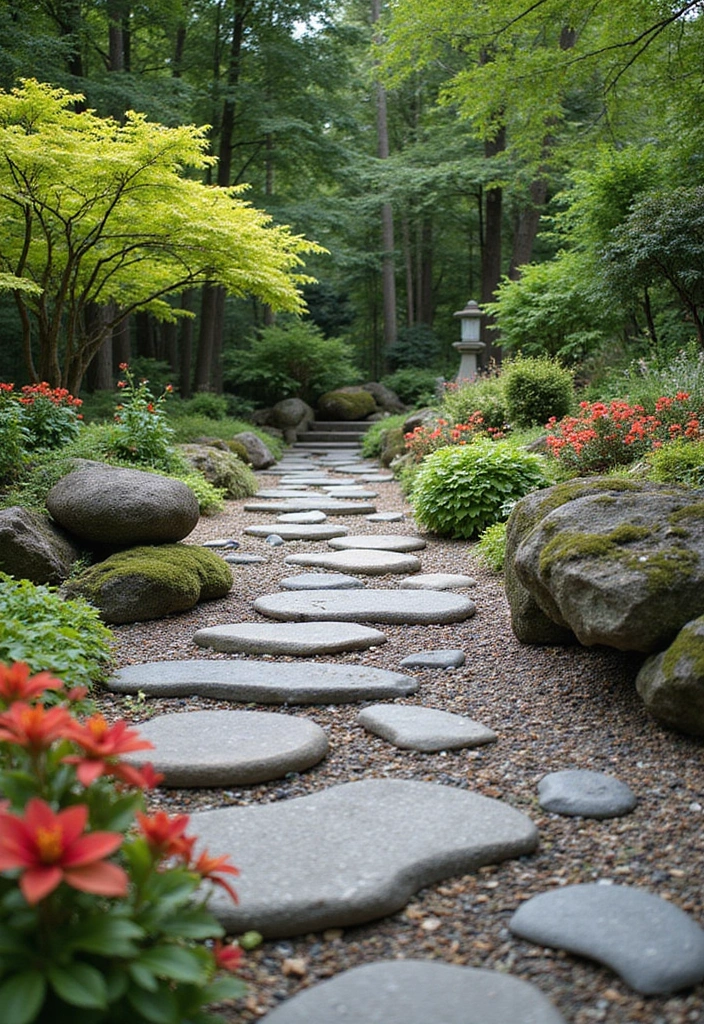
While Zen gardens are often associated with minimalism, adding colorful accents can bring vibrancy and life to your space. Incorporating colorful decorative stones can create unique patterns and focal points that draw the eye, stimulating joy and engagement within your garden. Consider using elements like brightly colored stones arranged in interesting designs, alongside flowering plants such as flowering plant seeds (cherry blossoms or irises) that add a touch of seasonal beauty.
To enhance the evening charm, introduce colorful outdoor lanterns that create a warm and inviting atmosphere as the sun sets. The key here is balance; maintaining the core principles of tranquility while introducing pops of color that elevate the experience.
Garden Tip: Use colors that resonate with the season to keep the garden dynamic and lively throughout the year.
13. Rustic Elements in Zen Gardens
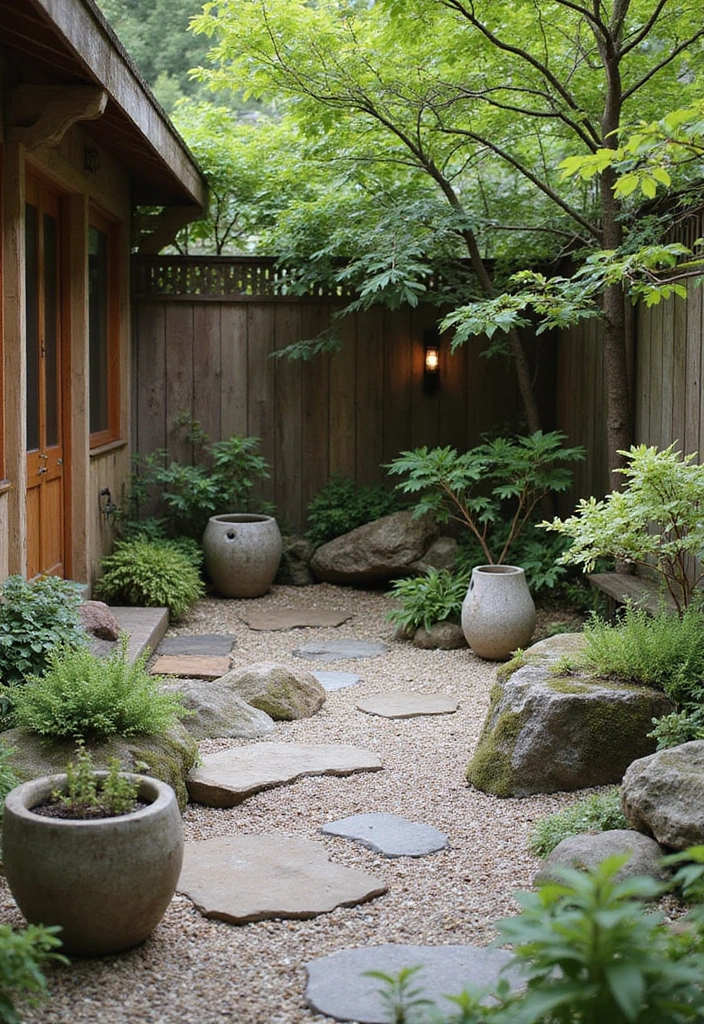
Incorporating rustic elements can add warmth and charm to your Zen garden. Think reclaimed wood, natural stone paths, and weathered planters that tell a story of time and nature. These elements create a harmonious contrast against the smooth textures typically found in Zen gardens. Here’s how you can introduce rustic charm:
– Use driftwood decorative accents as striking decorative pieces that bring a touch of nature indoors or outdoors. Their unique shapes and textures can serve as focal points in your garden, enhancing its organic feel.
– Create pathways from reclaimed wood garden pathway kit. This not only provides a practical element for walking but also adds aesthetic appeal to your garden, seamlessly integrating rustic charm with functionality.
– Incorporate terracotta plant pots set for your plants. The earthy tones and textures of terracotta provide a perfect complement to the rustic elements, enhancing the natural look of your garden.
Rustic features offer a sense of grounding, connecting your garden to the earth while still emphasizing simplicity and grace.
Garden Tip: Scavenge local flea markets for unique pieces that can add character to your space.
14. Zen Garden with Aromatherapy Plants
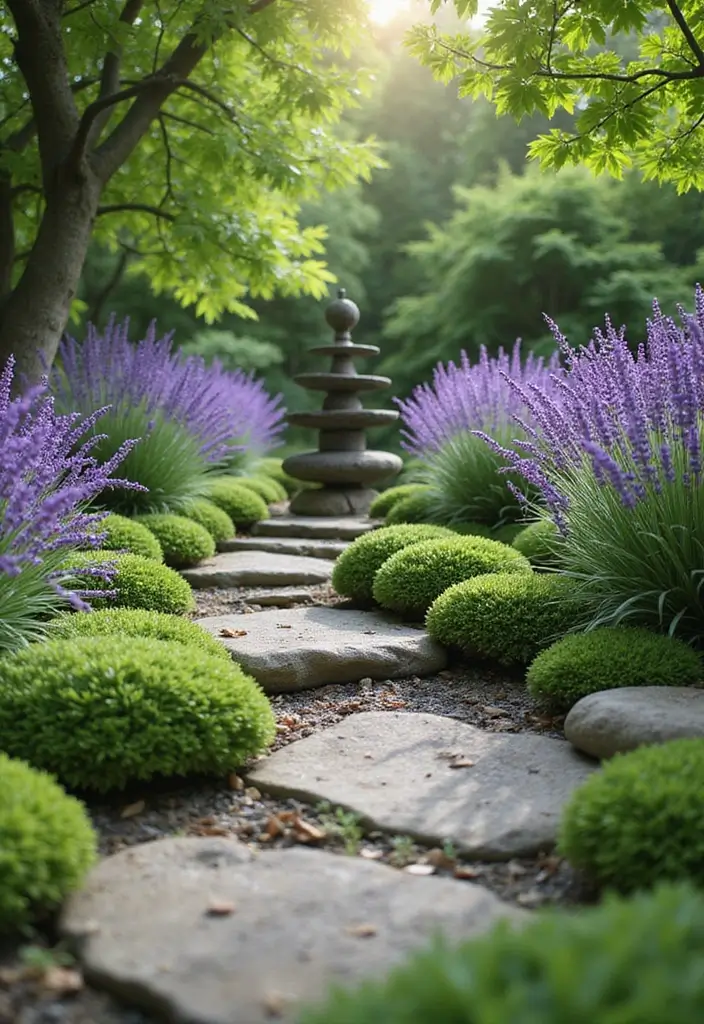
Integrating aromatherapy plants into your Zen garden can enhance the sensory experience, creating an environment that promotes relaxation and mindfulness. Choose fragrant herbs and flowers that evoke tranquility, such as lavender, rosemary, and chamomile. For an ideal addition, consider the lavender plant, which not only looks beautiful but also acts as a natural sleep enhancer. Plant clusters of lavender along paths or near sitting areas to fully enjoy their soothing scent.
Incorporating herbs that repel pests while still smelling refreshing can further enhance your garden experience. Additionally, bringing in an essential oil diffuser can help fill your meditation space with calming aromas. With its ultrasonic technology and variety of LED colors, it creates a serene atmosphere perfect for mindfulness practices.
Don’t forget to consider using scented candles like the Yankee Candle kitchen spice, which offers a warm, inviting fragrance. These candles can burn for up to 150 hours, adding a long-lasting touch of comfort to your garden setting.
The benefits of these plants and products extend beyond beauty; they can improve your mood and promote a sense of well-being.
Garden Tip: Use pots for herbs that can be moved closer to your seating area when in bloom for maximum fragrance.
15. Zen Garden Fire Pits
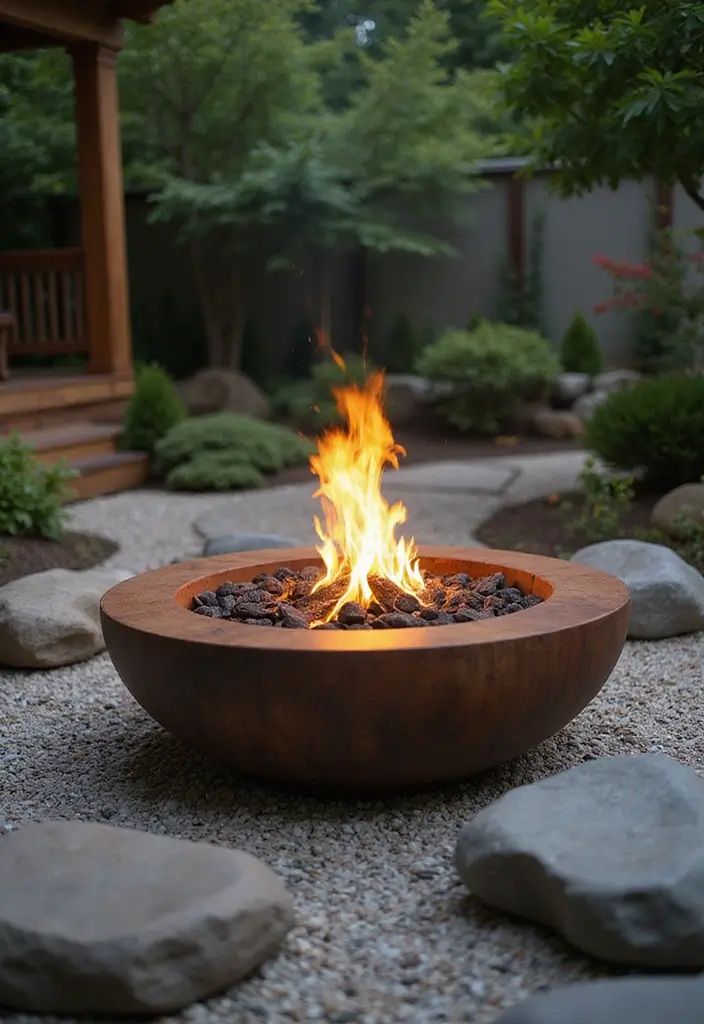
Adding a fire pit can create a cozy gathering spot within your Zen garden, enhancing the experience of relaxation and community. A simple stone fire pit can serve as a focal point for evening gatherings, allowing people to enjoy nature under the stars. For a seamless integration with your garden theme, consider using natural stones like Skyflame black natural tumbled stones round lava rock pebbles, which not only beautify the setting but also complement the serene atmosphere.
To make the fire pit area more inviting, surround it with comfortable seating. A stylish option is the Gizoon 3 piece patio bistro set, featuring modern wicker furniture that’s perfect for your yard or garden. The inclusion of a coffee table makes it an ideal spot for enjoying drinks and snacks while sharing stories with friends and family.
Additionally, safety should be a priority. Incorporating a fire pit spark screen is an excellent way to keep sparks contained while allowing you to enjoy the warmth of the fire. This heavy-duty mesh cover not only protects your guests but also ensures you can safely enjoy outdoor evenings.
This addition not only provides warmth but also fosters connection, inviting loved ones to gather. Remember to choose a fire pit design that complements the overall aesthetic of your garden, whether it’s modern or traditional.
16. Music in Zen Gardens
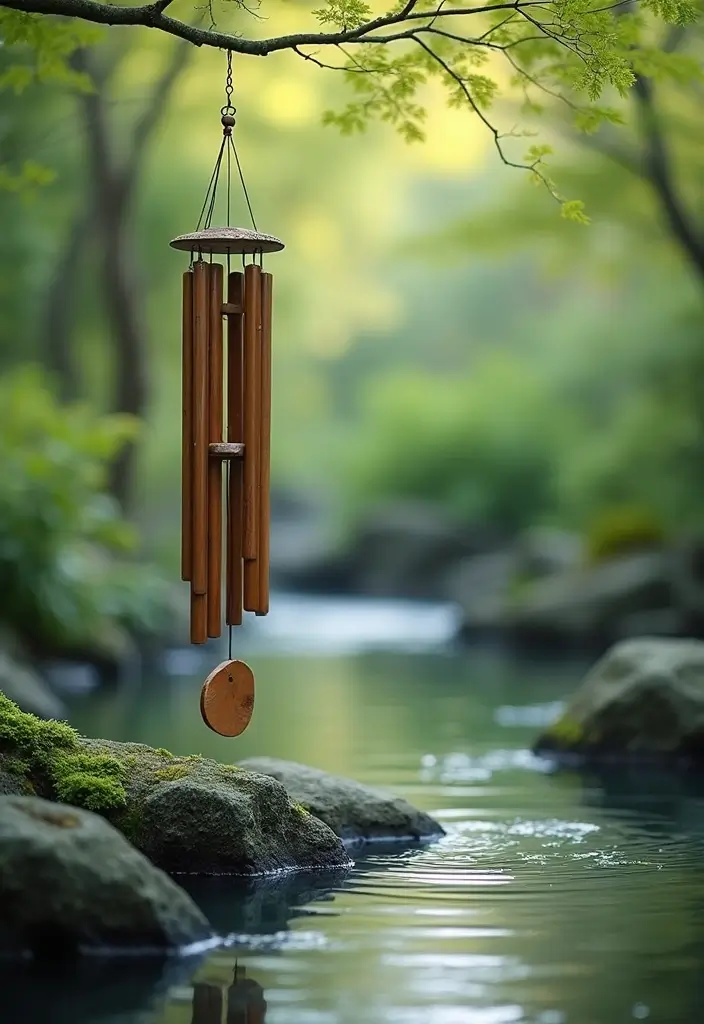
Incorporating musical elements can enhance the tranquility of your Zen garden. To create a soothing atmosphere, consider adding features like softly tinkling wind chimes, a small water fountain, and gentle background music. These auditory elements work together to foster a peaceful environment that elevates your meditative experience.
For a natural touch, you might want to consider natural bamboo wind chimes. Their gentle sounds blend seamlessly with the garden’s ambiance, producing a calming effect that brings you closer to nature.
A small water feature can also be incredibly soothing. You can opt for a solar-powered water fountain that creates tranquil water sounds while being eco-friendly. This addition not only enhances the auditory experience but also adds a lovely visual element to your garden.
To complete your serene setting, consider integrating Bluetooth outdoor speakers that can be discreetly placed among your plants. These speakers allow you to play gentle music or nature sounds, creating an immersive environment that engages all your senses.
Garden Tip: Remember to use natural materials for your wind chimes to ensure that their music harmonizes beautifully with the environment.
17. Zen Garden with Chalk Art
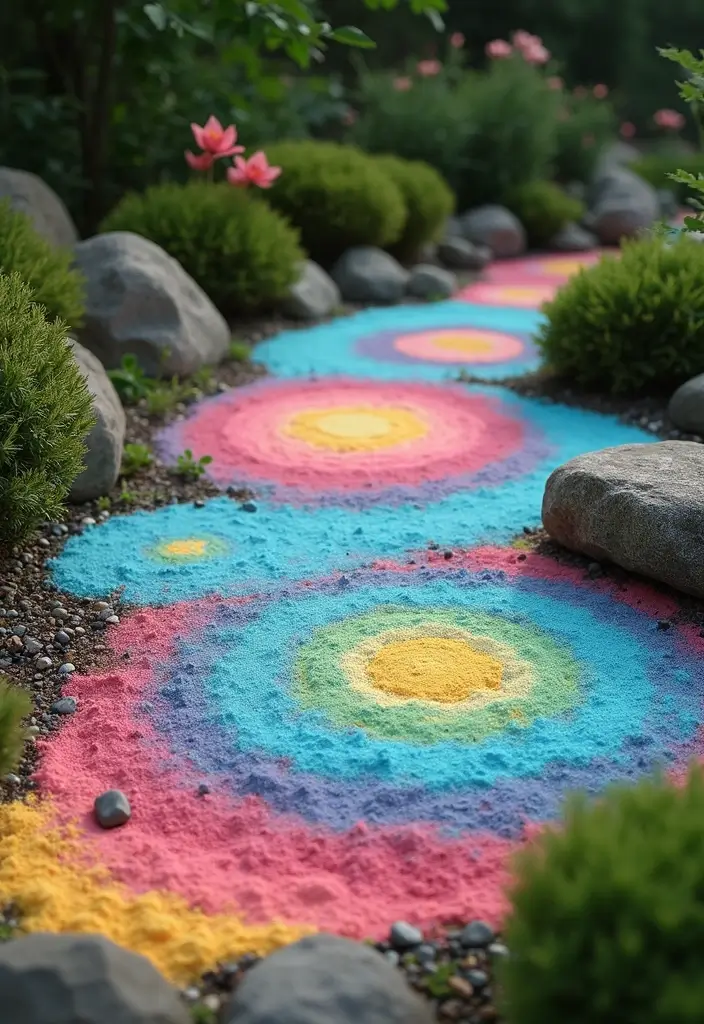
For a playful twist, incorporate chalk art into your Zen garden. This temporary art form allows you to express creativity while maintaining the garden’s serene aesthetic.
Use natural colors to create patterns or images that can wash away with rain, adding an ever-changing element to your garden. Consider designs inspired by nature, like leaves and flowers, or use garden mandala stencils that encourage mindfulness during creation. These stencils can help you craft beautiful mandalas that enhance the peaceful atmosphere of your space.
You might also want to add inspirational quote stones to your garden. These engraved rocks can serve as reminders of positivity and reflection, making your garden a truly inspiring place to be.
Finally, keep a chalk set for outdoor use on hand for spontaneous art sessions that connect you to your space. This encourages engagement with your garden, allowing you to reflect on the art while embracing the transitory nature of life.
Garden Tip: Remember that the beauty of chalk art is its impermanence, so enjoy the process as much as the result!
18. A Zen Garden for Wildlife
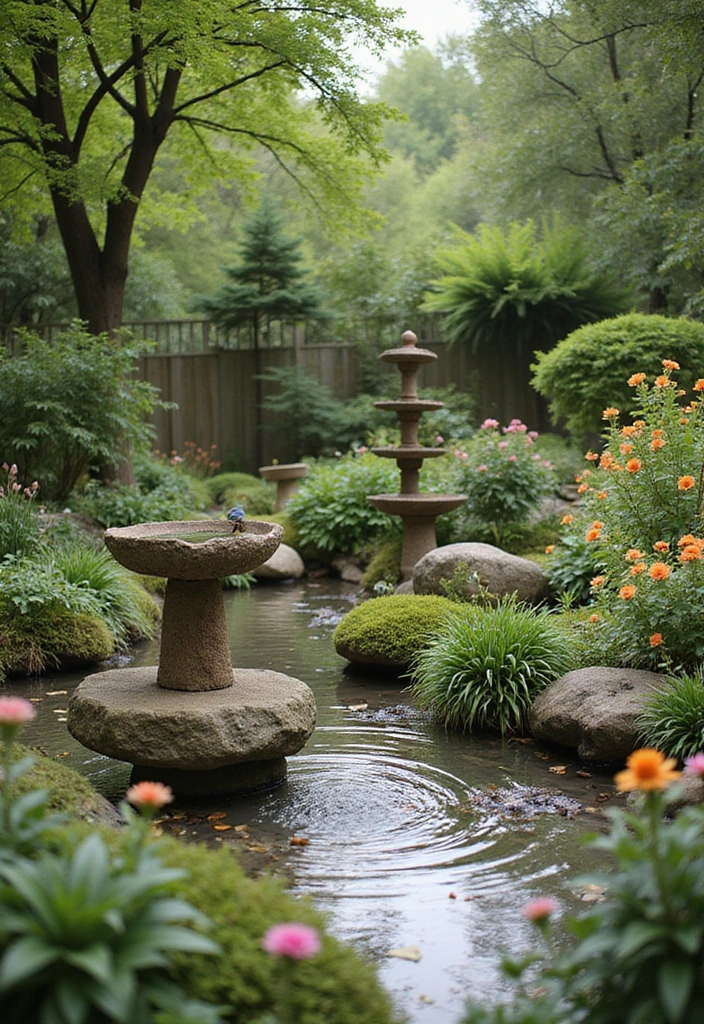
Designing a Zen garden that welcomes wildlife can create a harmonious balance between nature and mindfulness. By incorporating native plants and natural habitats, you’ll invite birds, butterflies, and beneficial insects into your space.
Consider adding a bird bath to provide hydration and a cooling spot for your feathered friends. This will not only attract various bird species but also encourage them to linger in your garden, enhancing its vibrancy.
In addition, planting native flowering plants seeds will bring an array of pollinators, such as bees and butterflies, to your garden. These plants are suited to your local environment and create a lively atmosphere while supporting the local ecosystem.
Furthermore, consider including a wildlife shelter or hideaway within your garden. This will provide a safe space for small animals, allowing them to feel secure and thrive in their environment.
This thoughtful approach not only enhances biodiversity but also deepens your connection with the ecosystem, fostering a sense of responsibility toward nature.
Garden Tip: Research native species that thrive in your area to create a garden that supports local wildlife.
19. Therapeutic Garden Elements
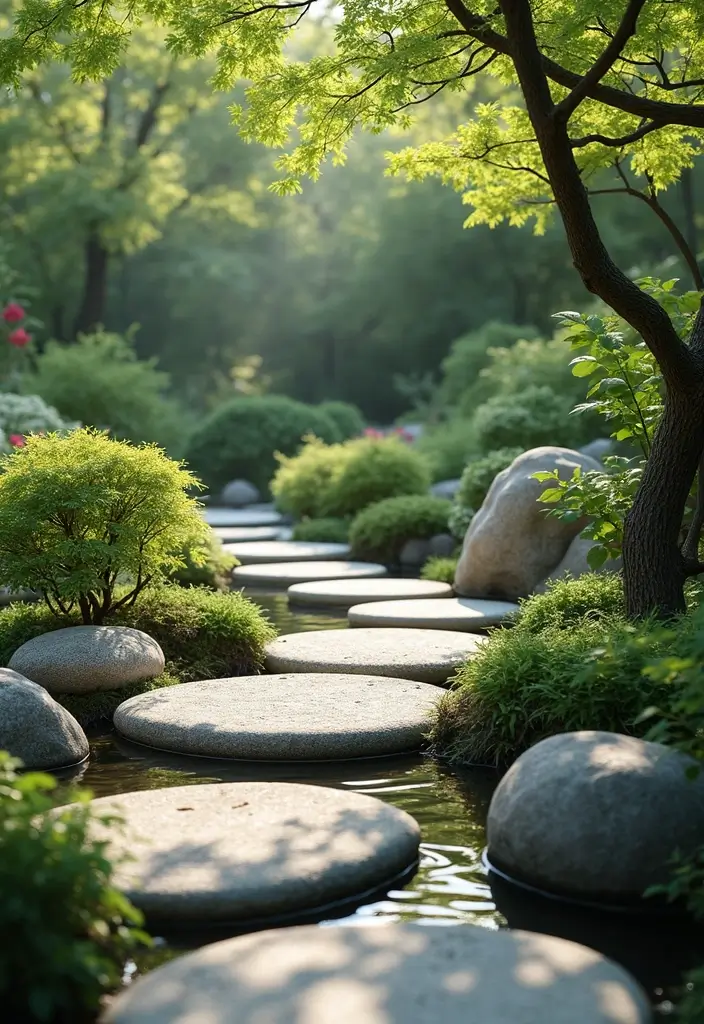
Integrating therapeutic elements into your Zen garden can enhance relaxation and healing. Consider features like sensory gardens, which engage all five senses, or meditation stones arranged in a mindful way.
To create a sensory-rich environment, you can incorporate textured garden path mats that provide tactile stimulation as you walk. These mats not only feel great underfoot but also add a unique visual element to your space. Additionally, consider different heights and layers in your garden design to keep the scenery engaging.
Aromatic plants can also play a significant role in soothing the spirit. Starting with a starter kit of aromatic plants, such as bonsai trees, can enhance the sensory experience with delightful fragrances. These elements create a holistic atmosphere, inviting a deeper connection with nature and promoting peace.
Finally, remember to keep areas open for spontaneous gatherings. This encourages community support and sharing, making your garden a welcoming space for all.
20. Creative Use of Lighting
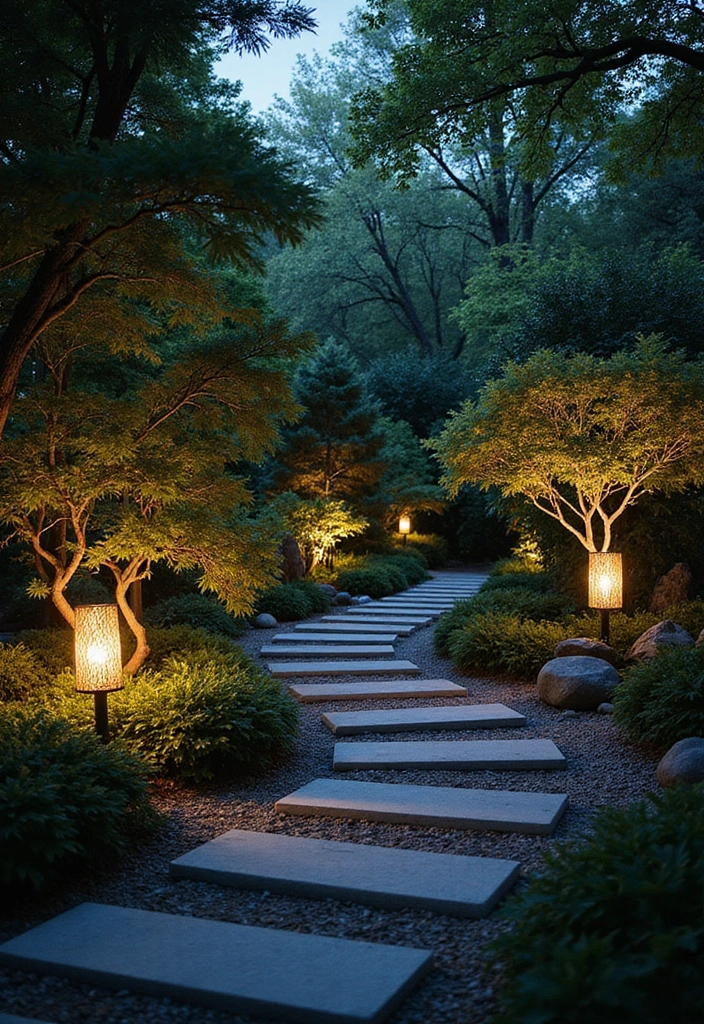
Lighting can dramatically alter the ambiance of your Zen garden, transitioning it from day to night seamlessly. Consider using solar-powered lights, such as the Solar-Powered Garden Lights, which blend naturally with the environment. These lights can illuminate pathways or highlight features, enhancing the beauty of your plants at night.
For creating a warm and inviting glow, you might also opt for warm white LED string lights. Thoughtfully placed in seating areas, these lights create a serene atmosphere perfect for evening relaxation.
If you have water features, consider the LED spotlight for water features. This option is designed to highlight the beauty of water while providing a dramatic effect as the sun sets.
The right lighting not only enhances the overall aesthetic of your garden but also makes it an inviting space day or night. Remember to choose warm-colored lights to maintain that calming atmosphere.
21. Integrating Modern Design
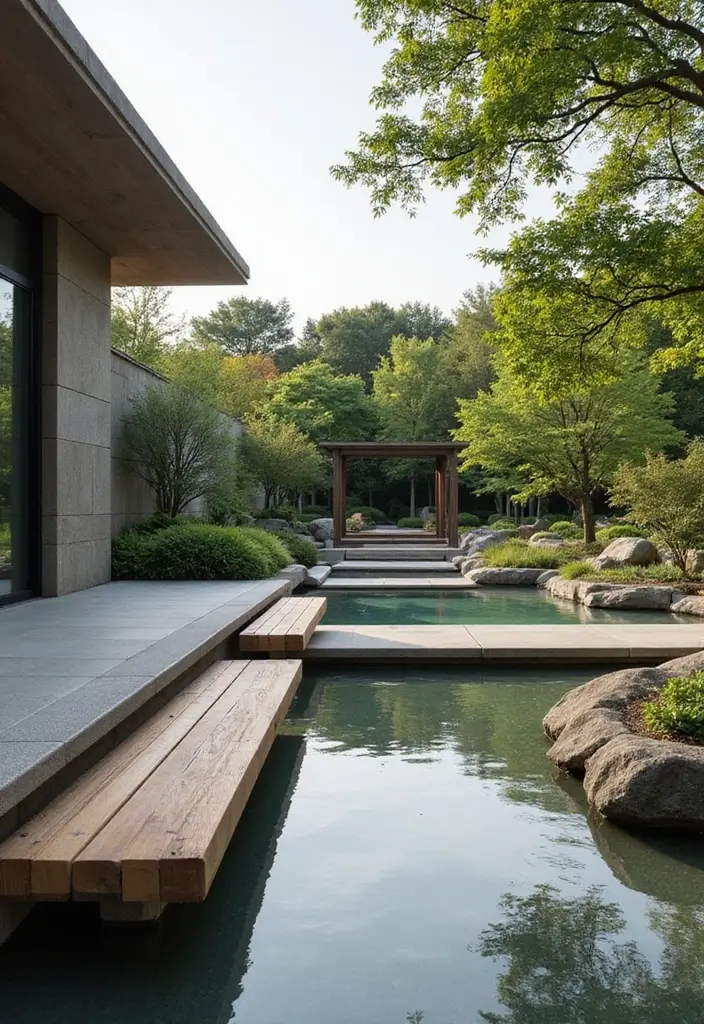
While traditional designs are enchanting, integrating modern elements can create a unique blend in your Zen garden. Consider incorporating sleek lines, geometric shapes, and minimalist materials that contrast with natural features to enhance the overall ambiance.
For instance, a concrete garden bench can serve as a striking focal point while providing a tranquil space for reflection. Its contemporary design harmonizes beautifully with the natural surroundings and invites you to pause and enjoy the serenity of your garden.
Additionally, a steel abstract sculpture can introduce an artistic flair, adding visual interest and a touch of modernity to your landscape. This type of sculpture not only enhances the aesthetic appeal but also serves as a conversation starter for visitors.
To create a cohesive pathway through your garden, consider using modular pathway pavers. These pavers allow for creative arrangements and varying heights, further emphasizing the modern design while providing a functional route through your Zen space.
This contemporary twist can attract a wider audience while retaining the essence of tranquility, offering a fresh take on Zen gardening.
Garden Tip: Balance modern elements with organic shapes to maintain harmony.
22. Zen Garden with Cultural Artifacts
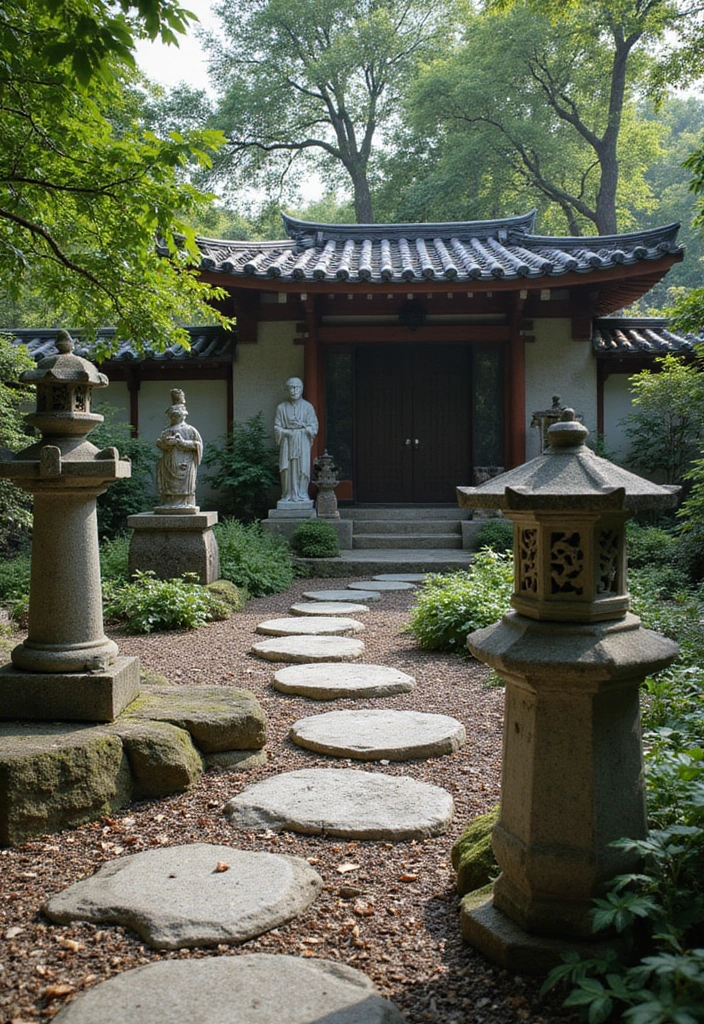
Incorporating cultural artifacts can enrich the narrative of your Zen garden, telling stories of heritage and history. Elements like statues, lanterns, or traditional pottery can serve as focal points to enhance your space.
Consider adding a stone lantern to guide the way through your garden. Its two-tier pagoda design not only provides illumination but also adds a touch of traditional Japanese aesthetics, inviting visitors to wander thoughtfully.
You might also include a meditation statue, such as the Veronese Design Mother Earth Gaia in a sitting lotus pose. This piece embodies peace and mindfulness, serving as a gentle reminder to center yourself and reflect on your journey.
Additionally, incorporating a simple ceramic water bowl can enhance the contemplative aspect of your garden. Not only does it provide an ideal spot for reflection, but its functionality also complements the serene environment, making it a perfect place for quiet moments.
These artifacts not only enhance the visual appeal but also create deeper connections to Zen culture, promoting understanding and appreciation.
Garden Tip: Choose items that resonate personally to create a garden that reflects your journey.
Incorporating cultural artifacts into your Japanese Zen garden isn’t just about beauty; it’s about creating connections to history and mindfulness. Each piece tells a story, inviting reflection and a deeper appreciation of Zen culture.
23. Zen Garden with Artistic Features
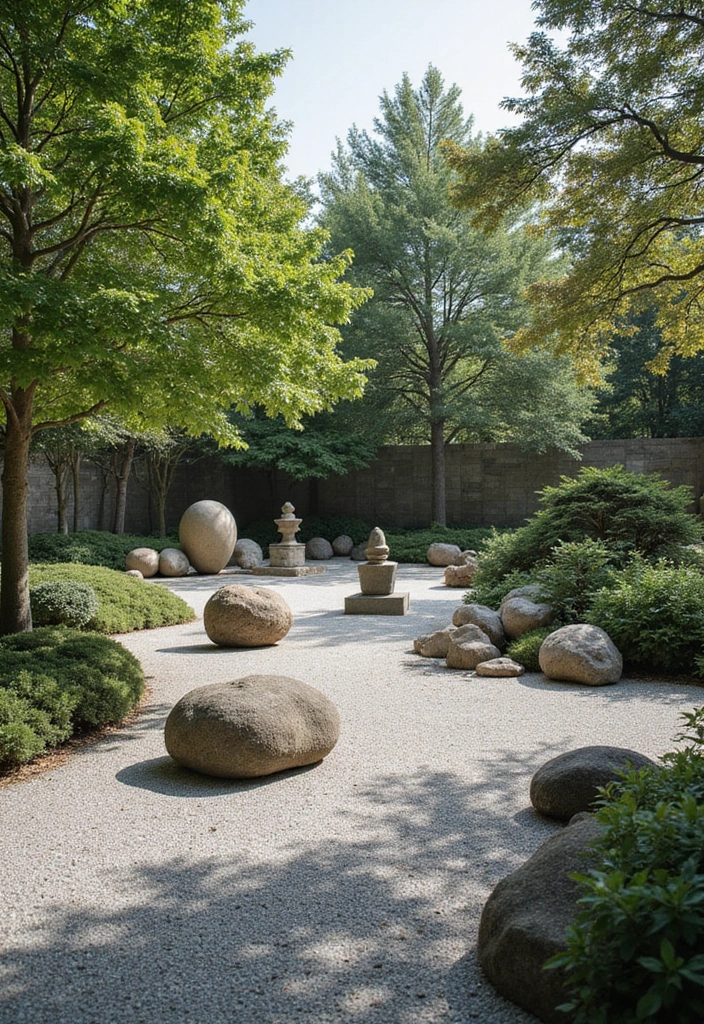
Integrating artistic features such as sculptures or installations can bring a sense of creativity to your Zen garden. These art pieces not only provide focal points of interest but also inspire thoughts and emotions, enhancing your mindful living experience.
Consider adding a natural stone garden sculpture like the Ancient Graffiti eight-stone balancing cairn. Crafted from natural materials, this sculpture beautifully complements the organic aesthetics of a Zen garden while encouraging a sense of balance and tranquility.
For a captivating effect, think about incorporating solar-powered garden lights. These lights can interact with light and shadow, adding a magical ambiance to your garden in the evening. Their unique design also makes them an interesting conversation starter, seamlessly blending functionality with art.
Additionally, you might want to include a dynamic element such as a wind spinner garden art. This wind sculpture moves gracefully with the breeze, offering a sense of movement and fluidity that serves as a reminder of nature’s ever-changing beauty.
Art can provide a unique perspective on Zen, reminding us that beauty comes in many forms. It invites exploration and conversation within the space.
Garden Tip: Choose art pieces that complement your garden’s overall theme and philosophy.
24. Seasonal Decorations in Zen Gardens
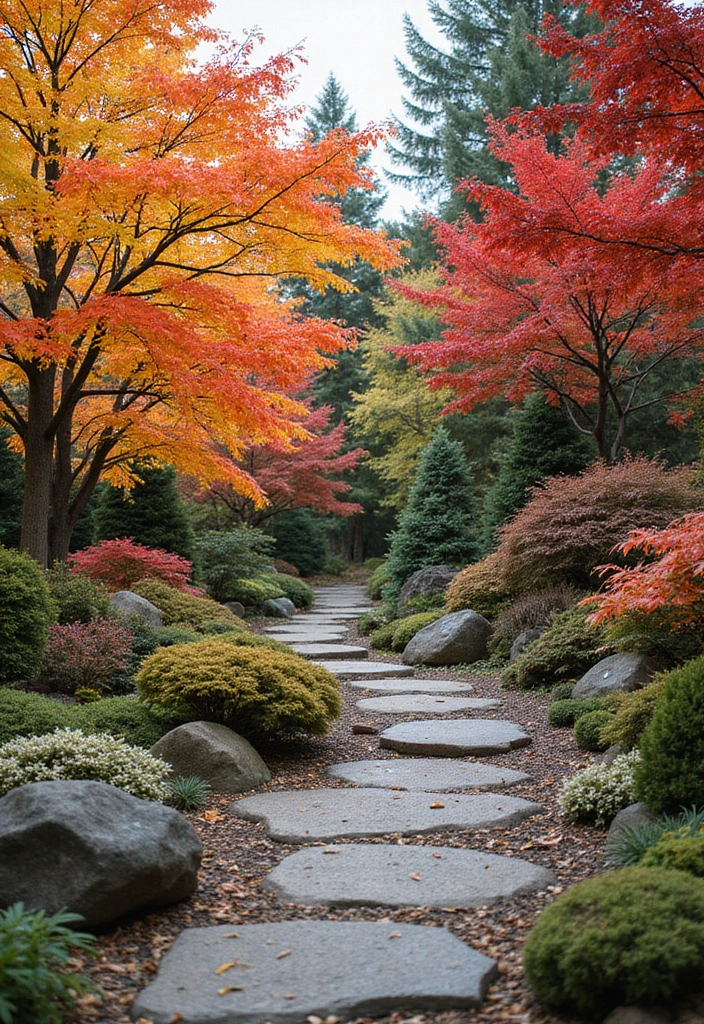
Seasonal decorations can add a festive touch to your Zen garden while honoring the cycles of nature. You can introduce elements like autumn leaves, winter lanterns, or spring blossoms as a way to celebrate each season’s uniqueness.
Consider incorporating seasonal flowers that bloom at different times, such as the vibrant blooms from the HOME GROWN 𝗨𝗦𝗔 𝗣𝗥𝗘𝗠𝗜𝗨𝗠 Zinnia Dahlia Seeds Pack. These easy-to-grow outdoor flowers can enhance the beauty of your garden and attract pollinators, making each season a visual delight.
Using natural decorations like pine cones or stones can also complement the landscape beautifully. For instance, the Hummingbird Stepping Stone serves as a perfect decorative element that adds character and a touch of nature, grounding your space in the earth’s beauty.
Additionally, adding festive lights during the holidays can create a joyful atmosphere in your garden. The addlon Solar-Powered Festive String Lights are a great option, providing enchanting illumination while being environmentally friendly. With various light modes and the convenience of being solar-powered, these lights will enhance the overall ambiance of your garden for seasonal celebrations.
These decorations not only enhance the experience of nature’s changing beauty but also offer something new for visitors throughout the year.
Garden Tip: Rotate decorations seasonally to keep the garden fresh and engaging.
25. Zen Garden Community Spaces
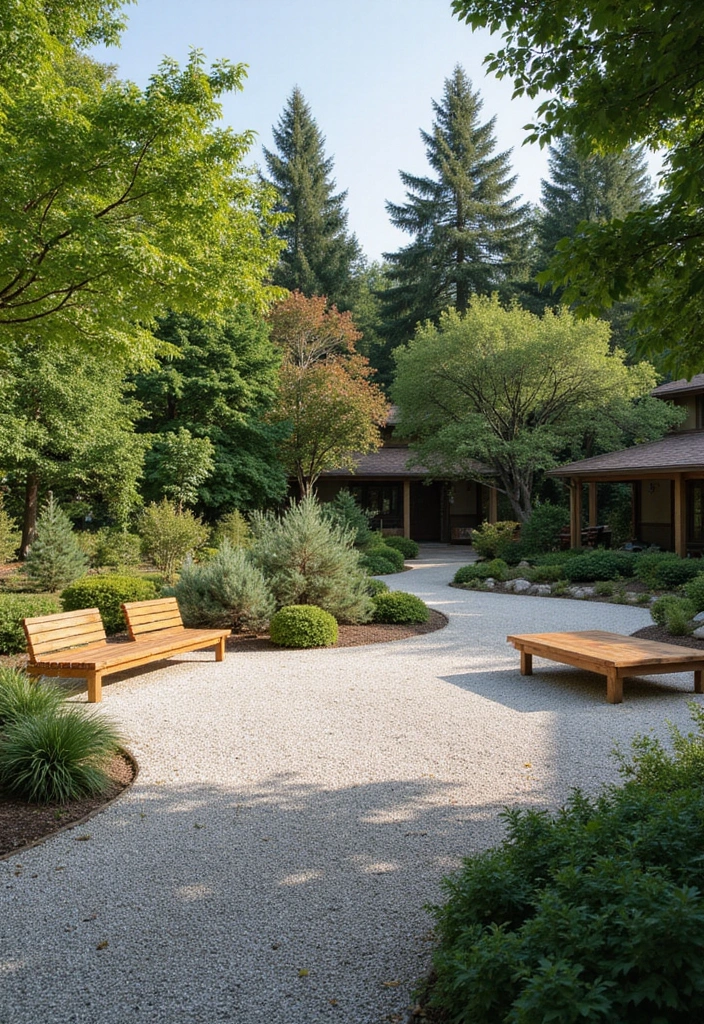
Creating communal areas within your Zen garden can foster community and enhance social connections. Spaces designed for gatherings encourage people to come together, share ideas, or simply enjoy nature. To make your garden more inviting, consider adding an outdoor picnic table for communal meals or casual meetings and garden benches to provide comfortable seating for relaxation or conversation.
You might also want to incorporate event spaces for community gatherings, where you can host seasonal garden events that draw the community together and foster shared experiences. Pair these gatherings with garden workshop supplies to engage with gardening enthusiasts and promote mindfulness through the act of nurturing plants and learning together. This approach not only nurtures relationships but also turns your garden into a vibrant hub of activity and connection.
26. Zen Garden with Natural Fences
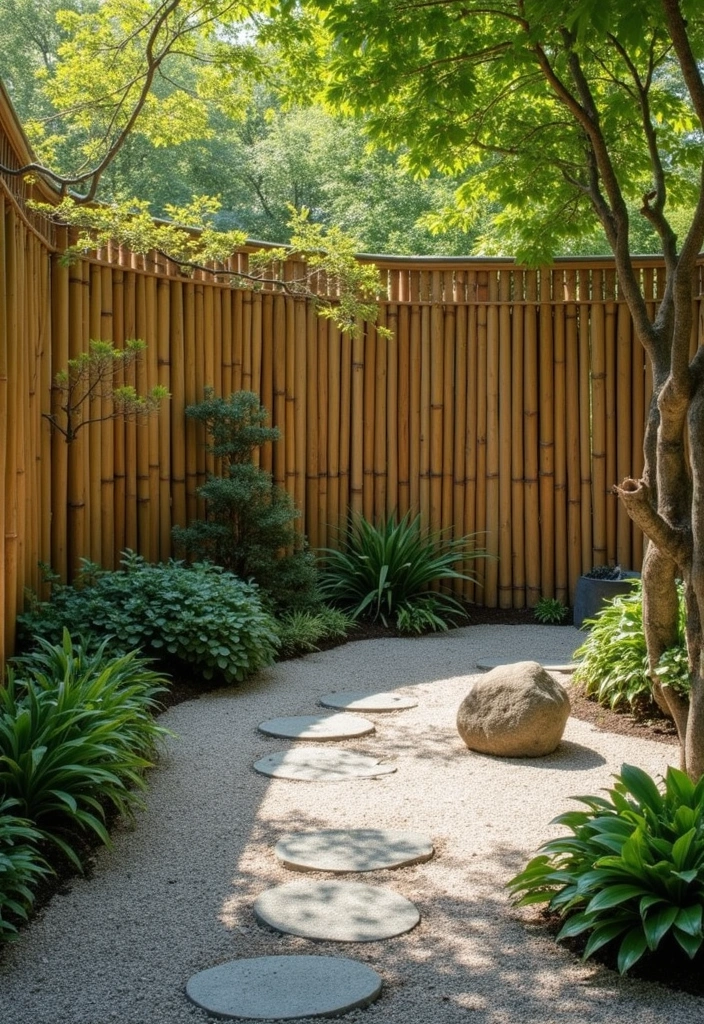
Using natural materials for fencing can enhance the Zen feel while providing privacy and protection. Elements like willow, bamboo, or wooden slats can blend seamlessly into the environment. For instance, you might consider constructing a bamboo fencing roll for a classic touch that not only looks great but also offers a sustainable option for your garden space.
Alternatively, you can use logs or driftwood to create barriers that bring a rustic charm to your Zen garden. If you’re looking for a more defined border, the wooden garden edging can serve as decorative small picket panels to frame your flower beds while maintaining the aesthetic harmony of your garden.
To enhance natural coverage and privacy, consider planting dense hedges. A great way to get started is with the hedge planting kit, which includes everything you need to nurture beautiful plants that can serve as a living fence.
These fences not only enclose your space but also enhance its beauty, complementing the overall aesthetics of your Zen garden.
Garden Tip: Choose fencing materials that are locally sourced and sustainable for an eco-friendly approach.
27. Zen Garden with Sculptural Water Elements
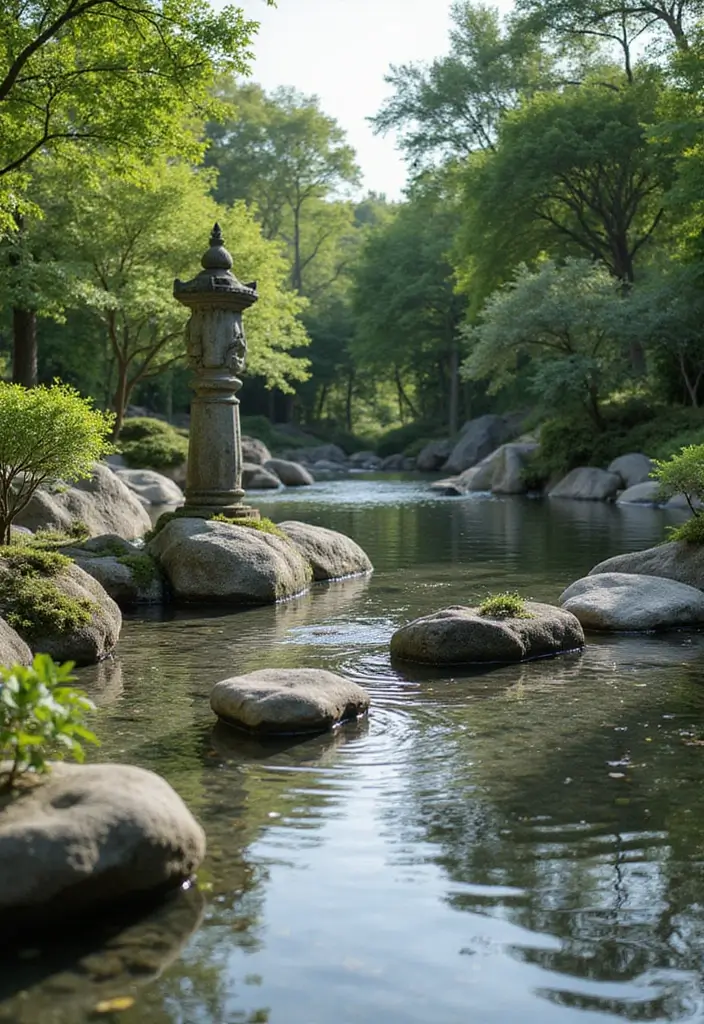
Sculptural water features can serve as stunning focal points within your Zen garden, marrying functionality with artistry. Consider installations like the Water Wall Fountain, which brings a calming presence with its antique bronze design. This water wall not only enhances relaxation but also creates a visual masterpiece that invites reflection.
You can also introduce large, decorative elements such as the large decorative garden bowl. This 16 by 8-inch chocolate bowl can be filled with aquatic plants, contributing to the natural design while providing a serene spot for contemplation.
To truly elevate your garden’s atmosphere, consider incorporating aquatic plants like aquatic plants for water features. These live plants not only beautify the water installations but also promote a peaceful ambiance through the gentle sound of flowing water.
Artistic water elements like these add a unique charm, creating a visually captivating and soothing environment. When selecting materials for your water features—whether it’s stone or glass for a contemporary twist—ensure they harmonize with the overall design for the best effect.
28. Zen Garden with Creative Seating Options
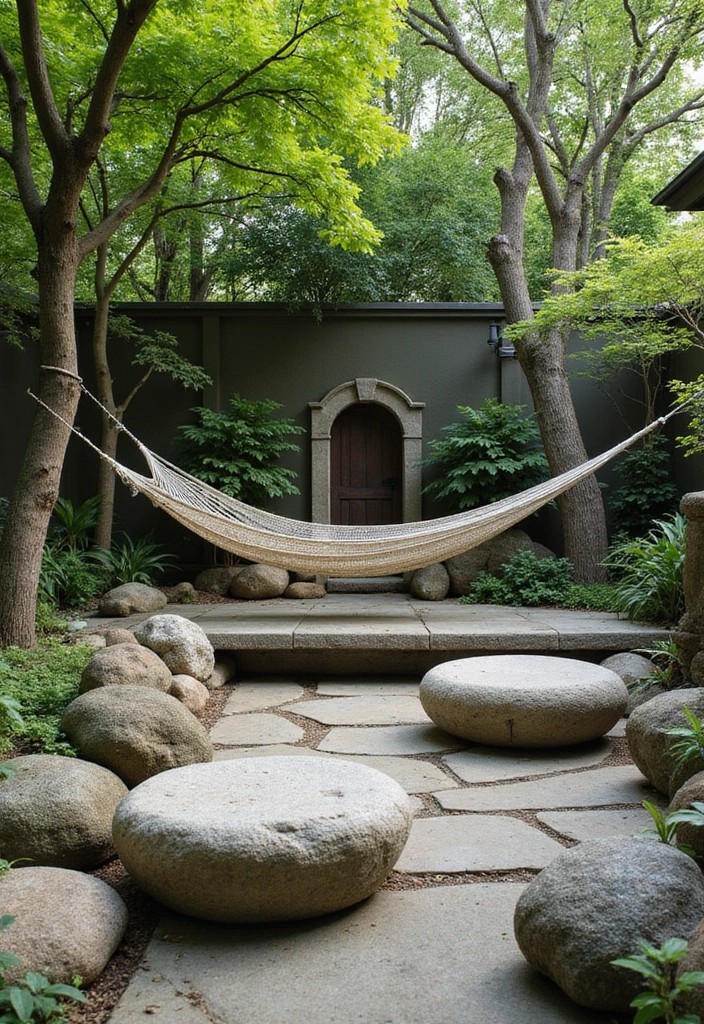
Unique seating options can enhance the comfort and functionality of your Zen garden, inviting visitors to linger and enjoy the beauty around them. Consider incorporating a natural stone bench made of lightweight resin for a rustic touch. This bench not only blends harmoniously with the natural surroundings but also provides a sturdy and inviting place to sit, perfect for quiet contemplation.
For a more relaxed atmosphere, adding a hammock can transform your garden into a laid-back retreat. Ideal for those lazy afternoons, this portable option is great for hanging between trees, allowing you to sway gently while enjoying the serene environment.
If you’re looking for something with more playfulness, consider a swing seat. This addition not only encourages a fun and informal vibe but also fosters social interaction among friends and family. With its sturdy design, it supports ample weight, making it a safe choice for relaxation.
These creative seating choices provide a range of experiences, whether it’s for quiet moments of reflection or lively social gatherings. The right seating can enhance the overall experience, encouraging mindfulness and relaxation in your garden.
Garden Tip: Arrange seating to encourage conversation while also allowing for peaceful solitude.
29. The Art of Zen Weaving
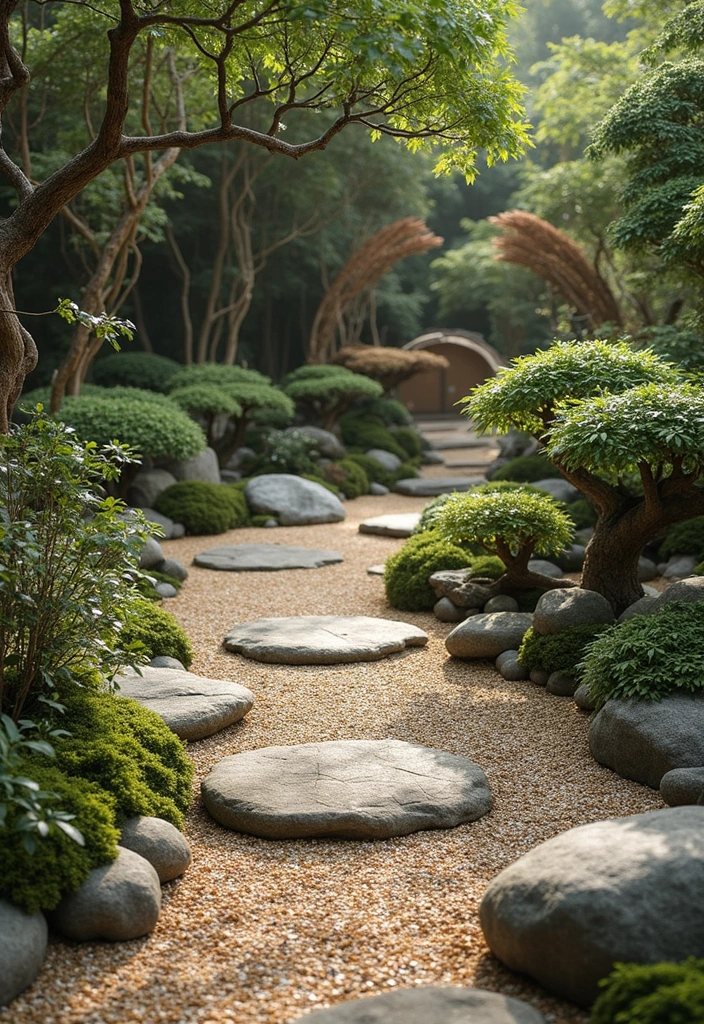
Zen weaving involves using natural materials to create unique patterns and designs in your garden, adding an artistic layer to its beauty. This could include weaving vines, twigs, or grasses into structures that can serve both form and function.
For instance, consider weaving living fences with vines or creating trellises that support flowering plants, which you can enhance with a garden trellis. The RUBFAC Metal Garden Arch is an excellent choice, as it offers a stylish structure for climbing plants, making it easier to integrate natural beauty into your zen garden.
You might also enjoy designing sculptures made from natural materials. To assist in your creative process, having the right tools is essential. A weaving tools set, like the WISEPRO 12 PCS Basket Weaving Tool Kit, can provide you with everything you need to craft intricate designs and structures, whether you’re a beginner or have some experience.
To tie your creations together, consider using natural twine for weaving. The PerkHomy Natural Jute Twine is perfect for supporting your various weaving projects, from securing plants to creating artistic features in your garden.
This technique not only beautifies your garden but also engages you in the creative process of gardening, promoting mindfulness and presence.
Garden Tip: Experiment with different weaving techniques to find what resonates with your artistic vision.
Conclusion
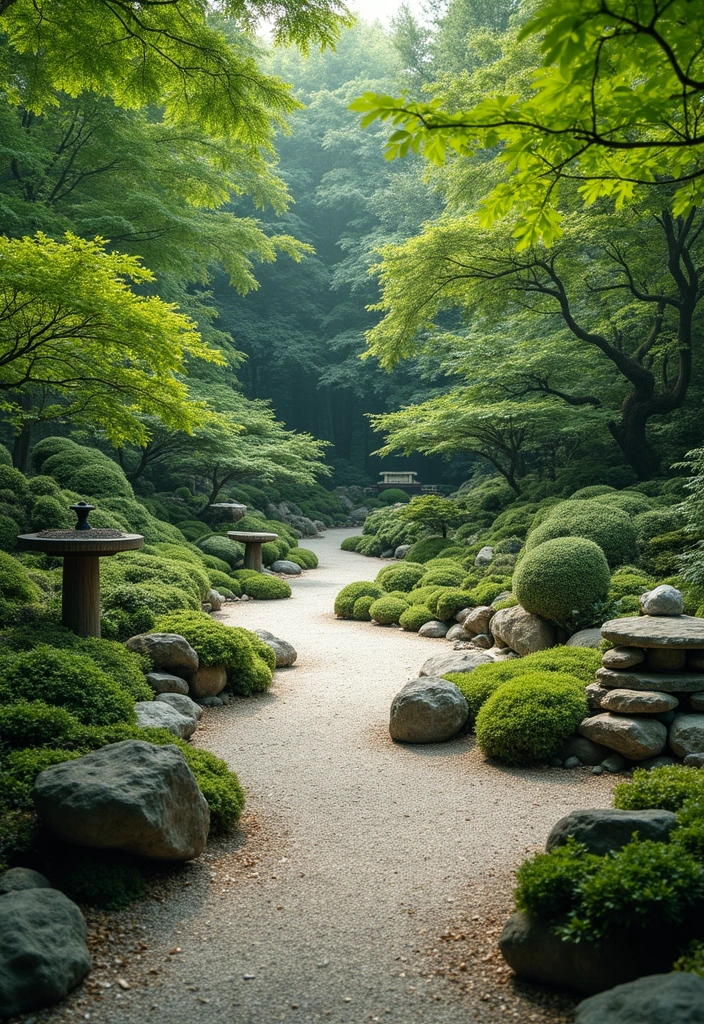
Embracing the beauty and tranquility of Japanese Zen gardens can be a profoundly rewarding journey.
By incorporating these concepts into your space, you’re not only creating an aesthetically pleasing environment but also fostering a deeper connection with nature and mindfulness.
Take the inspiration shared here to curate a garden that reflects your personal journey and philosophies, allowing it to be a serene haven in your life.
Note: We aim to provide accurate product links, but some may occasionally expire or become unavailable. If this happens, please search directly on Amazon for the product or a suitable alternative.
This post contains Amazon affiliate links, meaning I may earn a small commission if you purchase through my links, at no extra cost to you.
Frequently Asked Questions
What Are the Key Elements of a Japanese Zen Garden?
A Japanese Zen garden is all about simplicity and tranquility. Key elements include raked sand or gravel that represents water, strategically placed rocks that symbolize islands, and sparse vegetation like moss or bamboo. Each component is chosen to encourage mindfulness and reflection, creating a serene space for meditation and relaxation.
How Can I Make My Zen Garden More Eco-Friendly?
To create a more eco-friendly Zen garden, focus on using sustainable materials and native plants that require less water and maintenance. Incorporate composting practices and avoid chemical pesticides. You can also add a small pond to support local wildlife, enhancing biodiversity while maintaining the garden’s peaceful atmosphere.
Can I Include Edible Plants in My Zen Garden Design?
Absolutely! Incorporating edible plants into your Zen garden can merge beauty with functionality. Consider planting herbs like basil or mint, or even small fruit trees that enhance your garden’s visual appeal while providing fresh ingredients for your meals. This way, your garden becomes a peaceful retreat and a source of nourishment.
What Types of Pathways Work Best in a Zen Garden?
Pathways in a Zen garden should invite exploration while maintaining a natural aesthetic. Options include stepping stones, gravel, or wooden planks. Choose materials that blend seamlessly with your garden’s elements and guide visitors through the serene space, encouraging a mindful stroll amidst the calming surroundings.
How Do Seasonal Changes Affect a Zen Garden?
Seasonal changes can bring dynamic beauty to your Zen garden. By selecting seasonal plants, you can ensure that your garden evolves throughout the year, offering different colors and textures. Spring blooms, summer greenery, autumn leaves, and winter stillness each contribute to a unique experience, reminding us of nature’s cycles and the importance of mindfulness in every season.
Related Topics

